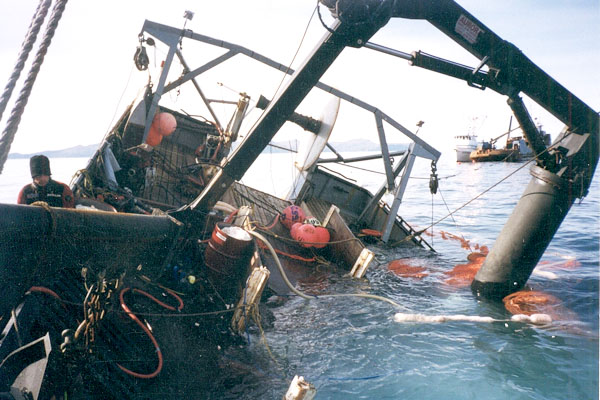
“It’s not just a job; it’s an Adventure”, says Wyatt Rankin, of Specialty Products, Inc. (SPI).
Who would have thought to use SPF to salvage boats? Wyatt Rankin and Dan Magone would.
Rankin Tells His Story of Experimenting with Foam to Salvage Boats:
In the spring of 1992, I got a call from my good friend Dan Magone, of Magone Marine Services, out of Dutch Harbor. He is well known on the Discovery Channel for doing boat salvages. I had done several run-of-the-mill Spray Foam and Polyurea Marine applications for him in the past. So, he asked for my help in doing a salvage operation.
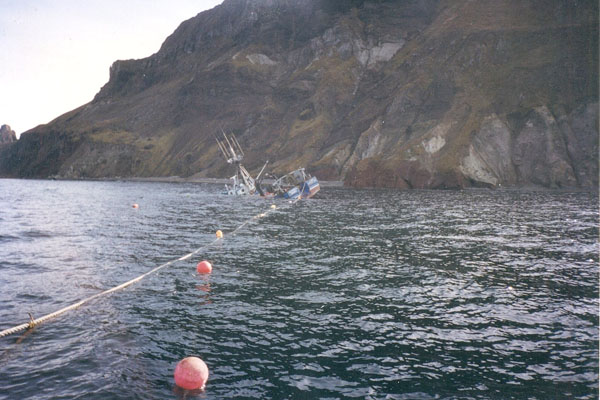
This crab boat, trapped on the rocks, is targeted for salvage.
Dan’s bread and butter comes from conducting marine salvage for the insurance companies, i.e. boats that have run aground for whatever reason and are still visible or create a hazard to marine navigation. When you travel around the Aleutian Islands, you will still see many wrecked boats on the beach or reefs that have been there for many years. New laws mandate that they can no longer be abandoned. They have to be removed by whatever means possible, even if it requires cutting them up into pieces and craning them onto a barge or moving the pieces with helicopters. That process can get very expensive. The most economical way, and the most preferred way for the insurance companies, is to float them off and either salvage or dispose of them another way.
In trips past, Dan and I had brain-stormed ideas for using foam under water to create buoyancy, in addition to other means of flotation. One of the most common methods of buoyancy is to seal off a compartment and use high volume, low-pressure air to displace the water. If the hull in that compartment has been breached; however, it will only displace the water down to the breach. This can create a way for the air to escape out of the breach; therefore, that will be all of the water you can get out of the compartment.
Dan had the perfect boat to experiment with. The All Alaskan, a 95 ft. Crab Boat, had run up on the rocks off Saint Paul Island during the winter King Crab season. Due to weather conditions, it had laid on the rocks through the rest of the winter and storms had beaten it to death but was still in one piece. The hull was breached in several places above water line, so water displacement with air was not going to be of much help. Time to fill that baby up with foam and see if it can float. We were off on an adventure!
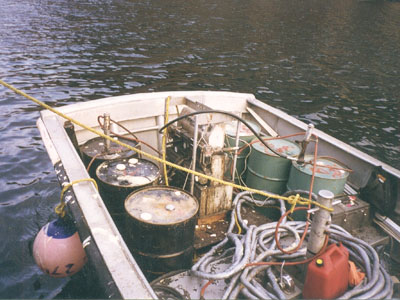
My Foam Skiff
We had 20,000 pounds of SPI Envelo-Pour pour foam shipped directly from SPI in Washington to Dutch Harbor. I air freighted my equipment out of Anchorage--A H-II, 160 ft. of hose, transfer pumps and misc. out to Dutch Harbor. When they received everything, they loaded it all on the Redeemer--Dan’s 200 ft. salvage boat--and headed for Saint Paul Island. I flew out and met them once they were there. The idea was to get that boat as full of foam as we could along with High volume/Low pressure air to create enough buoyancy to get it off the rocks. Some of it was easy because at low tide some of the compartments were above water line or at least only had a couple of feet of water in them. I would throw down mattresses, life jackets or even empty foam drums--anything I could use to get a pile of foam started on. Then, it was just a matter of filling the compartment full. The boat's bow (pictured below) shows the three buoys next to it. The light colored, round spot above the buoys is an open stateroom window in which you can see foam coming out of the window. There is another one forward just below the water line.
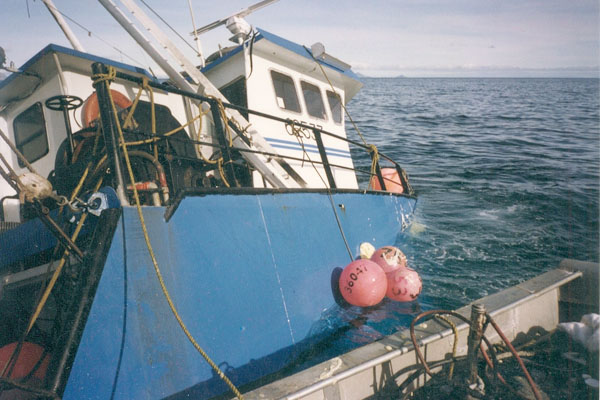
State room full of foam with open state room window above buoys
The compartments that were totally submerged, even at low tide, was where our brainstorm came into play. We brought rolls of 10 mil., 4 ft. diameter, polyethylene tubing. It was like one long baggie. The diver would go down and measure the compartment. I would cut the bag to length. I tied off the far end and ran a garden hose to the end and then tied the other end of the bag tight around the garden hose. The diver would work as many of those bags into the compartment as possible. I used a GX-7 gun with a drilled out #1 module. I built an adapter for the end of the gun, so I could screw the garden hose onto it. When the bags were in place it was just a matter of attaching the end of the hose to the gun and pulling the trigger and filling the bag. The diver pulled the hose back out of the bag as the foam grew so we didn’t cap off. Voila!!-foam under water!
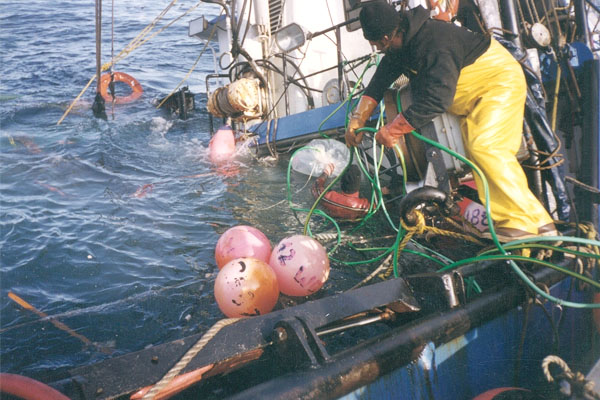
Bags being filled in forward compartments
Using Foam to Resurrect Boats is Possible
Everything went well, and we got all the foam in place. During this process, we also placed explosive charges in the bottom of the boat. Due to physical and salt-water damage, this boat was not salvageable. It was destined to be pulled out to deep water and sunk. We put the air to it, wherever it could be used, and the boat got light enough to float. However, we were unable to pull it free from the rocks. It would take a good storm swell to get it free. Now, we would have to wait for mother nature. My job was done, and it was back to Anchorage for me.

Foam all in place and water being pumped off to test for buoyancy
Mission Accomplished and the Ultimate Fate of The All Alaskan
I was sorry that I couldn’t stay for the grand finale. The next time I was out to Dutch, Dan showed me a video. A storm swell came in and they were able to pull it off the rocks and tow it out to be sunk. The crew--all good old Alaska Boys--were armed to the teeth with high power weaponry. They asked Dan if they could blow off some steam and use the boat for target practice before they sunk it. What Dan didn’t know is that they had filled several drums with oxygen and acetylene mixture and put them in the wheelhouse. A bullet found its mark and the explosion and fireball was magnificent. It blew the roof right off the wheelhouse. Almost as good as when they detonated the boat. It took about 10 minutes for the boat to sink beneath the waves. I was told that all that was left were chunks of foam everywhere. A couple of years later, I was in Sand Point and went down to walk the beach. I found several chunks of foam… and it made me wonder.
Wyatt Rankin manages Technical and Sales Support for Specialty Products, Inc. (SPI) in Texas. His SPF experience spans 35 years. He can be reached thru the Corporate Office at 800-627-0773.





